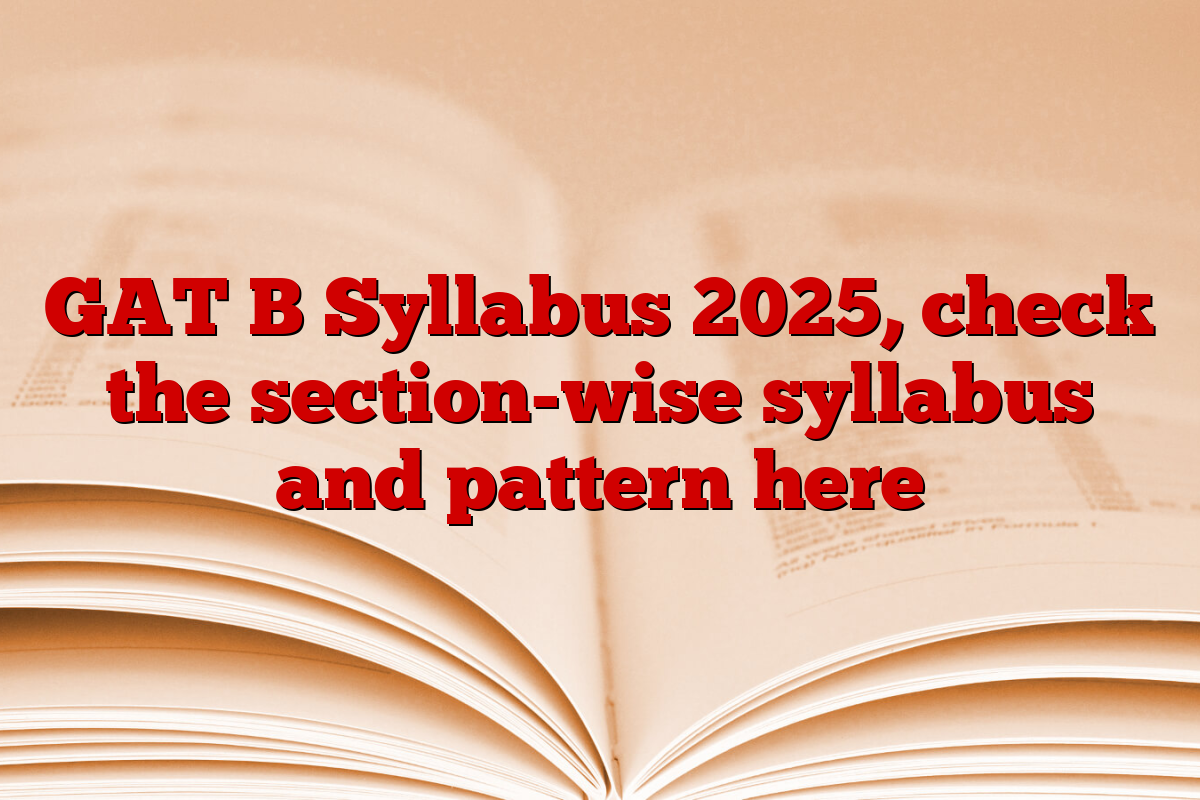Graduate Aptitude Test-Biotechnology (GAT-B) is a national level entrance examination conducted for admission to the DBT-supported Post Graduate (DBT PG) program in bio-technology in participating institutions and universities. The GAT-B 2025 exam is scheduled for 20 April 2025 (Sunday) and will be conducted as a computer-based test (CBT). This article provides a detailed observation of GAT B Syllabus 2025, exam pattern and section-wise syllabus to help aspirants prepare effectively.
GAT B Syllabus 2025: Overview
The GAT-B 2025 examination will include two sections: Section A and section B. Question Paper will include several options questions (MCQ) with a total duration of 180 minutes (3 hours). Graduate Aptitude Test Biotechnology below is a quick observation of 2025 syllabus and exam pattern:
| aspect | Description |
|---|---|
| Exam name | GAT Biotechnology 2025 |
| Examination method | Computer-based test (CBT) |
| Examination -pattern | Multiple choice question (mcq) |
| Duration | 180 minutes (3 hours) |
| test date | 20 April 2025 (Sunday) |
| Time | From 10:00 am to 01:00 pm |
| total marks | 240 |
| Total Questions | 160 (60 + 100 in Section A in section B) |
| Questions to try | 120 (60 + 60 in section A in Section B) |
GAT B exam pattern 2025
Graduate Aptitude Test-Biotechnology (GAT-B) is a national level entrance exam designed for admission to the DBT-supported Post Graduate (DBT PG) program in 2025 biotechnology. The examination is conducted as a computer-based test (CBT) and contains several options questions. The total duration of the examination is 180 minutes (3 hours), and is divided into two sections: Section A and Section B. In the Graduate Aptitude Test Biotechnology 2025 Examination, the unhytempled questions will neither be honored nor any marks will be cut off, which ensures any punishment for leaving unanswered questions.
GAT Biotechnology section-wise exam pattern
| Section | Number of questions | Questions to try | level | Per question mark | Negative marking | total marks |
|---|---|---|---|---|---|---|
| One segment | 60 | 60 (all compulsory) | 10+2 levels (Physics, Chemistry, Mathematics, Biology) | 1 | 0.5 marks were deducted for each wrong answer | 60 |
| Section B | 100 | 60 (out of 100) | Graduate Level | 3 | Cut 1 point for each wrong answer | 180 |
Download link to GAT B Syllabus 2025 PDF
The straight link of Downlaod Gat B Syllabus 2025 PDF is provided below. The NTA has released the official course PDF for both Section A and B in the PDF format. Graduate Aptitude Test Biotechnology syllabus link for East Access is provided below.
Download link to GAT B Syllabus 2025 PDF
GAT biotechnology courses for section A
The section A of the GAT-B 2025 examination focuses on testing the knowledge of candidates at 10+2 levels in four main subjects: Physics, Chemistry, Mathematics and Biology. This section consists of 60 compulsory multiple choice questions, each correct answer takes 1 digit. However, there is a negative marking of 0.5 marks for each wrong answer. Graduate Aptitude Test for Section A is designed to assess the fundamental understanding of these subjects, which are required to carry forward advanced studies in biotechnology.
| Subject | Key topic |
|---|---|
| Physics |
|
| chemistry |
|
| Mathematics |
|
| biology |
|
GAT biotechnology courses for section B
Block B of GAT-B 2025 examination focuses on subjects of graduate level in biotechnology, life science and related fields. This section includes 100 questions, of which candidates should try 60 questions. Each correct answer consists of 3 digits, with negative marking of 1 digit for the wrong answer. Graduate Aptitude Test Biotechnology syllabus for Section B is designed to test the intensive understanding of the candidates’ analytical thinking, problem-solution skills and advanced biotechnology concepts. Below is a brief breakdown of GAT biotechnology courses for section B in table format:
| Subject | Major subcontinent |
|---|---|
| Biological molecules | The structure and function of biomoleculus; Organic membrane, action capacity and transport processes. |
| Enzymes | Classification, canteix and mechanism of action. |
| Metabolism | Basic concepts and design of metabolism (carbohydrates, lipids, amino acids, nucleic acids); Photosynthesis, respiratory and electron transport chain; Bioergetics. |
| Germination | Virus structure and classification; Microbial classification and diversity; Microbial growth, nutrition and respiration; Nitrogen fixation; Microbial disease and host-romantic interaction. |
| cell Biology | Prokaryotic and eukaryotic cell structure; Cell cycles, development control, cell-cell communication, signaling and signal transduction. |
| Genetics | The molecular structure of genes and chromosomes; Mutation; Nucleic acid replication, transcription, translation; Mendelian heritage; Jean Interaction; Horizontal gene transfer; RNA intervention; DNA damage and repair; Chromosome variation; genetic disease. |
| Molecular technology | Principles of microscopy, centrifugation, spectroscopy, chromatography, electrophoresis and microerere. |
| Immunology | Congenital, humor and cell-medieval immunity; Antigen-angi reactions; MHC; Antigen processing and presentation; Immunity tolerance; Hypersensitivity; Autoimmune. |
| Bioinformatics | Sequence and structure database; Sequence alignment; Phylogeny; data mining; Molecular mobility and simulation. |
| Recipient DNA technology | restriction enzymes; Vactor; Jean cloning and expression; DNA sequencing; PCR; DNA fingerprinting; gene therapy. |
| Bio -technology of plant | Plant tissue culture; Transgenic plant; Plant products of industrial importance; In vitro germplasm protection. |
| Animal biotechnology | Animal cell culture; Hybridoma technology; Stem cell technique; Transgenic animals; Animal cloning. |
| Bioproose engineering | Principles of biorite design; Mass and heat transfer; Sterilization; Batch, fed-batch and continuous processes; Process scale-up. |
| Industrial biotechnology | Production of biofuels, bioplastics, industrial enzymes, antibiotics; Large scale purification of recreational protein; Bioramdiation. |
sharing is Caring!
